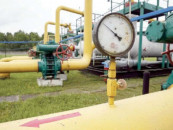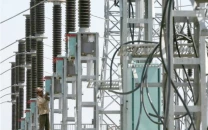Financing the revenue gap: Provinces refuse to bail out federation from financial trap
Refusal from provinces will further spoil Pakistan's case with the IMF which has suspended a $11.3b bailout programme.

Pakistan had borrowed $2.5b through Eurobonds on March 30 by offering lucrative interest rates to lenders. PHOTO: FILE
A firm ‘no’ from the four federating units will further spoil Pakistan’s case with the International Monetary Fund (IMF), which has suspended a $11.3 billion bailout programme since July 2010 due to Islamabad’s inability to deliver on key conditions, said a senior finance ministry official.
The “tough message” was given by the provincial finance secretaries in a meeting with the federal finance secretary on Tuesday.
In the federal budget 2010-11, the government had announced that it would restrict the budget deficit to 4 per cent of the size of the economy, or Rs685 billion, on the assumption that the four provinces will save Rs167 billion (1 per cent of GDP).
The failure to reform the energy sector, levy reformed general sales tax, check defence spending and non-issuance of 3G licences has already jeopardised the fiscal plan.
Officials have already told Prime Minister Yousaf Raza Gilani that, incorporating all these factors, the budget deficit may touch 7.5 per cent of GDP or Rs1.28 trillion.
The absence of the provincial surplus may push the budget deficit even beyond 8 per cent, provided the government does not take any corrective measures, said the official who attended the meeting.
The provinces told the federal government that generation of Rs167 billion was dependent on Rs1.67 trillion revenue collection, a provincial finance secretary told The Express Tribune. He spoke candidly on the issue on assurance that his identity will not be disclosed.
“The federal government informed us that the Federal Board of Revenue may not collect more that Rs1.5 trillion, so how can the provinces save the money,” he added.
Under the 7th National Finance Commission Order, the federal government transfers 56 per cent of the FBR revenue to the provinces.
Any shortfall in collection affects the federal transfers to the provinces. Another provincial finance secretary said the provinces’ 80 per cent budget is dependent on federal transfers and 75 per cent of their spending is obligatory on account of pensions, salaries and debt-servicing.
During the first half of the current fiscal, the four provincial governments managed to save Rs75 billion. The Balochistan government saved Rs23.2 billion, Khyber-Pakhtunkhwa, Rs18 billion, Punjab, Rs14 billion and Sindh, Rs20 billion.
The provincial finance secretary said that the saving occurred due to a temporary freeze on provincial Annual Development Plans in the aftermaths of this summer’s epic floods. It has been informed that most part of this saving will be consumed in the next six months, let alone additional saving, he added.
The issue of electricity dues also figured in the meeting.
Sources told The Express Tribune that the provinces disputed the federal figures and agreed to pay only the reconciled numbers. The federal government has worked out Rs7 billion electricity dues against the Punjab government but the provincial government puts the number at Rs4 billion.
The sources said that the Sindh government was the major defaulter with Rs51 billion pending dues.
Published in The Express Tribune, January 20th, 2011.



















COMMENTS
Comments are moderated and generally will be posted if they are on-topic and not abusive.
For more information, please see our Comments FAQ